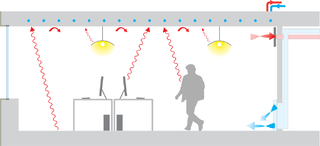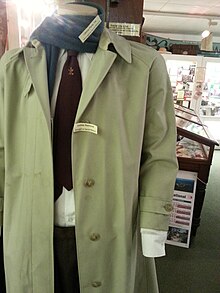
Charles Macintosh FRS was a Scottish chemist and the inventor of the modern waterproof raincoat. The Mackintosh raincoat is named after him.
The Mackintosh raincoat is a form of waterproof raincoat, first sold in 1824, made of rubberised fabric.

The Raincoats are a British experimental post-punk band. Ana da Silva and Gina Birch formed the group in 1977 while they were students at Hornsey College of Art in London.

The Weekly Standard was an American neoconservative political magazine of news, analysis, and commentary that was published 48 times per year. Originally edited by founders Bill Kristol and Fred Barnes, the Standard was described as a "redoubt of neoconservatism" and as "the neocon bible." Its founding publisher, News Corporation, debuted the title on September 18, 1995. In 2009, News Corporation sold the magazine to a subsidiary of the Anschutz Corporation. On December 14, 2018, its owners announced that the magazine would cease publication, with the last issue to be published on December 17. Sources have attributed its demise to an increasing divergence between Kristol and other editors' shift towards anti-Trump positions on the one hand, and the magazine's audience's shift towards Trumpism on the other.

Chrysalis Records is a British record label that was founded in 1968. The name is both a reference to the pupal stage of a butterfly and a combination of its founders' names, Chris Wright and Terry Ellis. It started as the Ellis-Wright Agency.

A raincoat is a waterproof or water-resistant garment worn on the upper body to shield the wearer from rain. The term rain jacket is sometimes used to refer to raincoats with long sleeves that are waist-length. A rain jacket may be combined with a pair of rain pants to make a rainsuit. Rain clothing may also be in one piece, like a boilersuit. Raincoats, like rain ponchos, offer the wearer hands-free protection from the rain and elements; unlike the umbrella.

Velvet Revolver was an American hard rock supergroup consisting of Guns N' Roses members Slash, Duff McKagan and Matt Sorum, alongside Dave Kushner formerly of punk band Wasted Youth, and Scott Weiland formerly of Stone Temple Pilots. The band formed in 2002 and was active until 2008, when Weiland left the band abruptly to rejoin Stone Temple Pilots.

An air mattress is an inflatable mattress or sleeping pad.

Michael Andrew "Duff" McKagan is an American musician. He was the bassist of hard rock band Guns N' Roses for twelve years, with whom he achieved worldwide success in the late 1980s and early 1990s. McKagan rejoined the band in 2016, following their induction into the Rock and Roll Hall of Fame.

A mattress is a large, usually rectangular pad for supporting a lying person. It is designed to be used as a bed, or on a bed frame as part of a bed. Mattresses may consist of a quilted or similarly fastened case, usually of heavy cloth, containing materials such as hair, straw, cotton, foam rubber, or a framework of metal springs. Mattresses may also be filled with air or water.

Comfort food is food that provides a nostalgic or sentimental value to someone and may be characterized by its high caloric nature associated with childhood or home cooking. The nostalgia may be specific to an individual or it may apply to a specific culture.
Robert Jeremy Hugh Lascelles is a British music industry executive and occasional musician. He is a second cousin to King Charles III.
Underlay may refer to flooring or roofing materials, bed padding, or a musical notation.

Elena Kagan is an American lawyer who serves as an associate justice of the Supreme Court of the United States. She was appointed in 2010 by President Barack Obama and is the fourth woman to serve on the Court.
Joseph Kagan, Baron Kagan was a Lithuanian-British industrialist and the founder of Kagan Textiles, of Elland, which made raincoats from the waterproof Gannex fabric he had invented. Gannex raincoats were worn by Prime Minister Harold Wilson, a friend of his. Kagan was sent to prison for ten months in 1980 for tax evasion.

Jockey International, Inc. is an American manufacturer and retailer of underwear, sleepwear, and sportswear for men, women, and children. The company is based in Kenosha, Wisconsin. Jockey invented the first men's Y-Front brief in 1934 and it is a recognized trademark in 120 countries.
Jerome Kagan was an American psychologist, who was the Daniel and Amy Starch Research Professor of Psychology at Harvard University, as well as, co-faculty at the New England Complex Systems Institute. He was one of the key pioneers of developmental psychology.
Layered clothing is the wearing of multiple garments on top of each other.

Radiant heating and cooling is a category of HVAC technologies that exchange heat by both convection and radiation with the environments they are designed to heat or cool. There are many subcategories of radiant heating and cooling, including: "radiant ceiling panels", "embedded surface systems", "thermally active building systems", and infrared heaters. According to some definitions, a technology is only included in this category if radiation comprises more than 50% of its heat exchange with the environment; therefore technologies such as radiators and chilled beams are usually not considered radiant heating or cooling. Within this category, it is practical to distinguish between high temperature radiant heating, and radiant heating or cooling with more moderate source temperatures. This article mainly addresses radiant heating and cooling with moderate source temperatures, used to heat or cool indoor environments. Moderate temperature radiant heating and cooling is usually composed of relatively large surfaces that are internally heated or cooled using hydronic or electrical sources. For high temperature indoor or outdoor radiant heating, see: Infrared heater. For snow melt applications see: Snowmelt system.

Textile performance, also known as fitness for purpose, is a textile's capacity to withstand various conditions, environments, and hazards, qualifying it for particular uses. The performance of textile products influences their appearance, comfort, durability, and protection. Different textile applications require a different set of performance parameters. As a result, the specifications determine the level of performance of a textile product. Textile testing certifies the product's conformity to buying specification. It describes product manufactured for non-aesthetic purposes, where fitness for purpose is the primary criterion. Engineering of high-performance fabrics presents a unique set of challenges.















